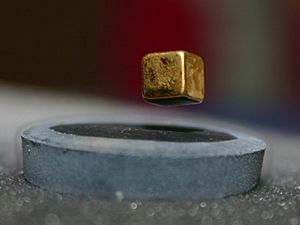Meissner effect facts for kids

The Meissner effect is a cool trick that happens when certain materials, called superconductors, become super cold. When they reach this super cold temperature, they suddenly push out any magnetic fields around them. Imagine putting a superconductor near a big magnet. If you could look inside the superconductor, you'd see that the magnetic field almost completely disappears! This is one of the special things that makes superconductors different from regular conductors.
Contents
What is the Meissner Effect?
When a material becomes a superconductor, it kicks out magnetic fields from its inside. This means that if you have a magnet nearby, its magnetic field won't be able to go through the superconductor. Instead, the field gets pushed away, making the magnetic field just outside the superconductor even stronger. This is a key property of superconductors, showing they are not just "perfect" conductors that let electricity flow without resistance.
Who Discovered the Meissner Effect?
This amazing effect was first noticed in 1933 by two scientists named Walter Meissner and Robert Ochsenfeld. They were studying how magnetic fields behaved around superconductors and saw this unique pushing-out action. Their discovery helped us understand much more about how superconductors work.
How Does the Meissner Effect Work?
One of the most exciting ways to see the Meissner effect is by watching a magnet float, or "levitate," above a superconductor. To do this, the superconductor needs to be cooled down a lot, often using something like liquid nitrogen.
When the superconductor gets cold enough, it starts to act like a magnet itself, but pointing in the opposite direction to the real magnet above it. This creates a pushing force that repels the real magnet. Because of this push, the magnet can't get any closer to the superconductor and ends up floating in the air! It's like two magnets pushing each other away, but one of them is a special superconductor.
Images for kids
-
A tin cylinder in a special container filled with liquid helium, placed between the poles of an electromagnet. The magnetic field is about 8 millitesla.
See also
 In Spanish: Efecto Meissner para niños
In Spanish: Efecto Meissner para niños




